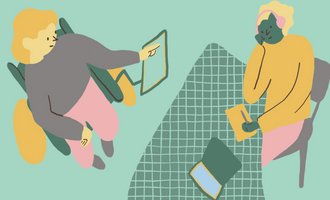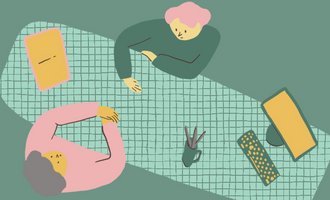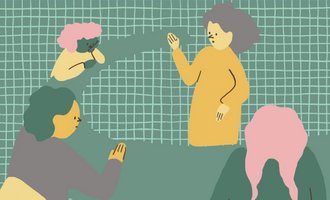The Bauhaus-Universität Weimar strives to enable equal access for all students and staff, and offers specific assistance and advice for people with disabilities or a chronic illness. The »Inclusive University« work group can gladly answer any questions you may have regarding your impairment and organisation of your studies or workplace at the Bauhaus-Universität Weimar.
Visible / Perceptible Impairments
Physical Disabilities
Students with a physical disability may have limited mobility, i.e. they may use a walking aid or wheelchair. A physical disability can also mean the limited ability to move one’s arms or the amputation of limbs. Organ damage, such as heart issues or kidney disease, which can also result in major physical limitations, is considered a physical disability. For students with a physical impairment, everyday (university) life often requires more energy and/or time. Some students have a study assistant to support them in their daily studies. They are dependent on a seat in the lecture hall where the study assistant can sit with them and where there is generally more space (e.g. for a wheelchair or walking aids).
Blindness and Visual Impairments
There are many forms of visual impairment, which differ in their cause, progression and extent. All have in common that (in most cases) they cannot be recognised at first glance. Huge differences also exist in the extent of blindness, i.e. blind does not always mean completely blind. A blind person may still be able to distinguish between light and dark, for example, or to make out the outlines of objects. Vision also depends on external factors such as lighting conditions. Bright lights do not always mean better vision though. Someone who is sensitive to glare can actually see better in dim light. Colour and contrast also play a major role. In order to be more recognisable, fonts do not always necessarily have to be very large – a person with tunnel vision can actually manage better with smaller fonts. Overall, people with a visual impairment need more time during their daily studies to process literature, for instance, and greater concentration, as they are unable to take information in visually (or only to a limited extent).
Deafness and Hearing Impairments
It is often not immediately obvious that someone has a hearing impairment or is deaf. For example, a person with a hearing impairment may simply initially seem rude to a hearing person if they do not reply when being spoken to when, in reality, they may not have heard that they were being addressed. In the case of hearing impairments, the time of onset of the impairment plays an important role. If deafness manifests at a very early age, a person’s articulation and speech comprehension may be affected. If someone is deaf from birth, sign language is their mother tongue and written language is then a foreign language for them. The grammar of sign language is fundamentally different from that of spoken language, which is why difficulties in written language, such as grammar and spelling, are not uncommon. The volume at which one speaks is not the only decisive factor for communication, but also the tone of voice. Depending on the hearing impairment, a hearing aid is not always suitable to compensate for the impairment. Especially in groups of people, it is not possible to filter out what individuals are saying as the hearing aid also amplifies all background noise. For students with a hearing impairment, lectures require a high level of concentration, especially when discussions are held and/or there is a lot of background noise. They may become tired faster as a consequence. Even if a sign language interpreter is used, the person with a hearing impairment has to concentrate very hard. In addition, those with hearing impairments may only be able to concentrate on one thing: either on the sign language interpreter or on the presentation slides, for example.
Non-Visible Impairments
Dyslexia and Dyscalculia
Dyslexia refers to a reading and spelling disorder. The extent of this disorder can vary significantly and can also relate more to reading or to writing. The cause of this learning disorder in which auditory and visual perception is impaired is a neurobiological brain dysfunction. Subtle differences in language cannot be heard. Fonts can also affect the ability to correctly understand written texts. The outcome is a deficiency in translating spoken language into written language and vice versa. Typically, people with this disorder make a great many spelling, grammatical and punctuation errors. However, the manifestations are different, hence reading and spelling disorders can also manifest separately. Dyscalculia is an analogous disorder that relates to the comprehension, processing and reproduction of arithmetic calculations. Students with particular difficulties in reading, spelling and arithmetic need more time. These disadvantages can be compensated for by granting additional time for written assessments, assigning greater weight to oral performance, providing aids or even waiving assessment of the spelling (assessment protection).
Speech Disabilities
A stammer is one example of a speech disability. The causes of stammering have not yet been researched in any depth. What is certain, however, is that it is a disorder in the flow of speech. A person’s emotional state and stammering can be closely connected; the situation can also play a major role. Someone might not stammer when in familiar company, but have difficulties conversing with strangers or speaking during a lecture. The key symptoms are the repetition of individual letters, syllables or whole words, stretching of individual letters or sounds, and blocking whereby the speaker wants to say something but cannot produce the word. This may result in difficulties in oral presentations or examinations. Stammering may also be accompanied by motor symptoms, facial tightening, nodding the head, pulling up the shoulder or hitting the thigh with the arm. Another accompanying symptom may be altered breathing, speaking at an increased volume and using filler words or phrases (e.g. »like«, »uh« or »um«) to maintain the flow of speech. Many affected people withdraw from social life when the fear of stammering and the negative reactions to it become too great. The stammer often affects their everyday life so much that activities are chosen according to whether and how much speaking is necessary.
Mental Illnesses
There are a variety of mental illnesses that differ in their cause and degree of impairment as well as their development and treatment. These include eating disorders, anxiety disorders and phobias, personality disorders and depression. The reasons for these are complex, but usually involve a combination of physical, psychological and social factors. It is characteristic of mental illness that the affected person often does not – or does not want to – recognise or address their illness. In many cases, mental illness is also associated with anxiety, insecurity, low self-esteem and lacking self-confidence. In addition, there are also physical symptoms such as palpitations, headaches or gastrointestinal complaints that can also be related to mental illness. Insomnia, low resilience and reduced concentration are common, too. Medication can make many sufferers feel subdued and fatigued. Since these illnesses often occur in phases, in some cases renewed onsets of the illness must be expected following an initial illness and sometimes also after very long periods of stability. The study duration can be prolonged as a consequence both due to lengthy acute phases of the illness as well as to a subsequent reduction in capabilities. The latter can occur in affective and cognitive areas, but also in the autonomous nervous system and lead to reduced energy, insecurity in perception, mood swings or social withdrawal. The focus is on the type and extent of possible disorders when it comes to organising everyday university life. During an acute phase, it normally isn’t possible to study or to complete examinations; the focus is on medical treatment and therapy during this time. A mental illness often cannot be discerned from the outside. The expectations placed on affected persons are thus the same as those placed on students without any impairments. One danger associated with this expectation is constant intense pressure to adapt, which can ultimately lead to excessive demands on the affected person.
Chronic Illnesses
A »chronic« illness is one that persists for at least six months, such as rheumatism, Crohn’s disease, asthma, multiple sclerosis, autism, neurodermatitis, hepatitis or diabetes. These illnesses can be physical or psychological in nature. Both the illnesses and the side effects of the necessary medication can make studying difficult. Most chronic illnesses are not noticeable, even after a long time. Many of these illnesses manifest in phases or there can be relapses. Even with good medication, relapses are unpredictable. Therefore, students with a chronic illness often find it very difficult to make long-term plans and cannot always attend courses regularly. Many illnesses lead to a reduced ability to work under pressure and to perform and concentrate. They can also be associated with mood swings. Pain, changes in the weather and side effects of medication can additionally have a negative impact on general well-being. Students may need to take regular breaks, stick to set mealtimes and take medication regularly due to their illness.
Catalogue of Measures
The action plan for implementation of the UN Convention on the Rights of Persons with Disabilities (CRPD) at the Bauhaus-Universität Weimar is aimed at people who »have long-term physical, mental, intellectual or sensory impairments which in interaction with various barriers may hinder their full and effective participation in society on an equal basis with others« (Article 1 sentence 2 UN CRPD). Inclusion is understood as a continuous process of change, recognising existing barriers in order to reduce or compensate for them step by step.
The term »accessible« relates to buildings and other facilities, means of transport, technical commodities, information processing systems, acoustic and visual information sources and communication facilities as well as other designed areas of life if they can be found, accessed and used by persons with disabilities without any particular difficulty and essentially also without external assistance.
The action plan is aimed at students, teachers and staff with disabilities as well as the entire university public. It takes into account the following fields of action defined by the Bauhaus-Universität Weimar, which reflect both the main requirements for action in inclusion and the target groups:
- accessible communication
- studying and teaching
- structural accessibility
- employees
Building plans and floor plans
See here (Accessible document) for maps of the Bauhaus-Universität Weimar for accessible studying, research and work.

Digital access is an important way for people with disabilities to obtain comprehensive information. We support you in making your websites, documents, videos, etc. accessible and available.
Legislation exists to ensure equal access to higher education for students with impairments and thus reinforce their rights. The legal regulations must be enforced in order to meet the declaration of the German Rectors’ Conference (Hochschulrektorenkonferenz, HRK) published in 2009 on »One University for All«. In higher education legislation and social law, the authors generally refer to the definition of disability as formulated in the Book IX of the German Social Code (Sozialgesetzbuch, SGB IX).
»Hochschulrahmengesetz« (German Higher Education Framework Act), Thuringian Higher Education Act (Thüringer Hochschulgesetz, ThürHG), study and examination regulations of the Bauhaus-Universität Weimar
Regulations specifically relating to access and admission to undergraduate and Master’s degree programmes as well as to equal opportunities for students with disabilities can be found in Articles 3 and 20 of the German Basic Law (Grundgesetz, GG), Articles 2 and 16 of the German Framework Act for Higher Education (Hochschulrahmengesetz, HRG), Articles 53, 55, 68 and 69 of the Thuringian Higher Education Act (Thüringer Hochschulgesetz, ThürHG), and in the regulations for the individual degree programmes at the Bauhaus-Universität Weimar.
German National Association for Student Affairs (Deutsches Studentenwerk, DSW)
A »chronic illness« is a long-lasting illness or one that follows an episodic course. They include chronic intestinal diseases and epilepsy, along with other conditions such as rheumatism, epilepsy, multiple sclerosis or allergies. If these lead to an impairment of social participation, they ultimately meet the legal definition of »disability«.
UN Convention on the Rights of Persons with Disabilities (UN CRPD)
In the UN CRPD, which has also been ratified by the Federal Republic of Germany, the concept of disability has been developed further and places greater emphasis on social barriers in accordance with the principle of »We are not disabled, we are being disabled«:
Article 1 and Preamble to the UN CRPD
»Persons with disabilities include those who have long-term physical, mental, intellectual or sensory impairments which in interaction with various barriers may hinder their full and effective participation in society on an equal basis with others.«
German Social Code (Sozialgesetzbuch, SGB)
Article 2 paragraph 1 SGB IX
A person has a disability if their physical function, mental ability or psychological health is very likely to deviate from the condition typical for their age for longer than six months and their participation in social life is therefore impaired. They are at risk of disability if an impairment is to be expected.
Article 2 paragraph 2 SGB IX
A person has a severe disability if they have a degree of disability of at least 50% and if they are legally resident, ordinarily resident or employed in a job within the meaning of Section 73 within the area covered in this code.



